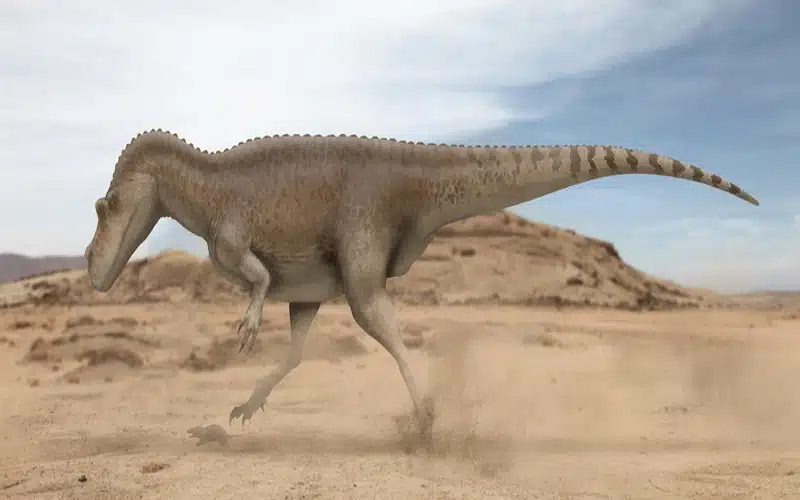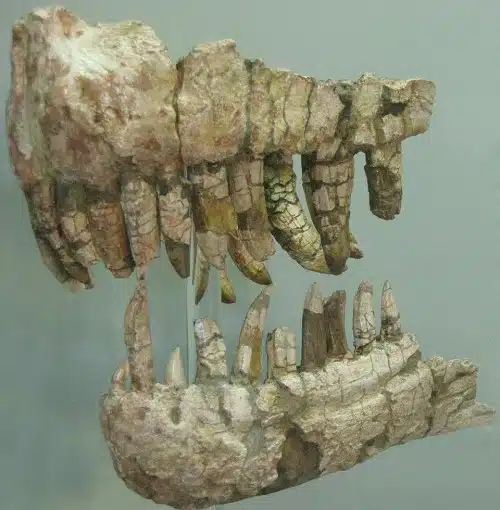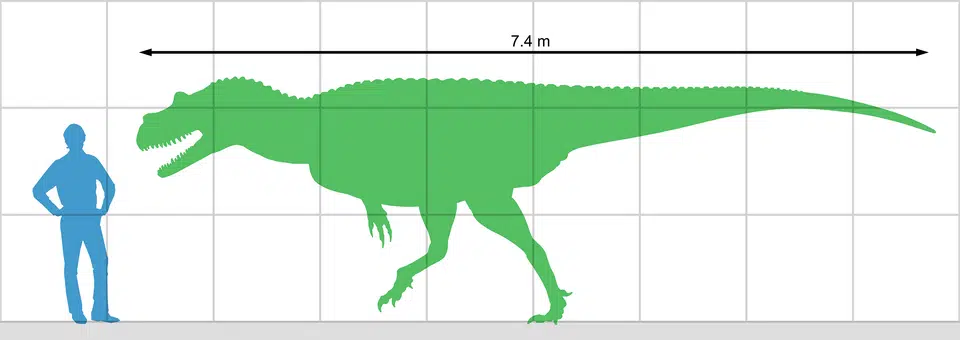The Early Cretaceous Period, spanning from approximately 145 to 100.5 million years ago, was a time of significant environmental change and evolutionary diversification, during which many recognizable dinosaur groups emerged or evolved into more specialized forms. Among these dinosaurs was Genyodectes, a theropod that roamed the southern reaches of the globe, leaving behind scant-yet-intriguing fossil evidence that helps us better understand the dynamics of Cretaceous ecosystems. This modest-sized yet fierce predator was part of the ceratosaurid family and likely played a specialized role in the food chain, preying on smaller animals and possibly scavenging on occasion.
Discovered in the fossil-rich region of Patagonia, Argentina, Genyodectes may not have been among the giants of its time, but it holds scientific importance for what it reveals about Cretaceous theropods in South America. Its remains, found in the Paso de Indios region, offer rare insights into the diversity and geographic spread of ceratosaurids, shedding light on how these predators adapted to distinct environments and coexisted with other dinosaur species.
Genyodectes Key Facts
| Keyword | Fact |
|---|---|
| Pronunciation | gen-ee-oh-DEK-teez |
| Meaning of name | Jaw Bite |
| Group | Theropoda |
| Type Species | Genyodectes serus |
| Diet | Carnivore |
| When it Lived | 125 to 113 MYA |
| Period | Early Cretaceous |
| Epoch | Aptian |
| Length | 20.5 to 24.0 feet |
| Height | 6.5 feet at the hips |
| Weight | 1,740 pounds |
| Mobility | Bipedal |
| First Discovery | 1901 by Arthur Smith Woodward |
| Holotype | MLP 26-39 |
| Location of first find | Canadon Grande, Chubut Province, Argentina |
Genyodectes Origins, Taxonomy, and Timeline
The name Genyodectes, derived from the Greek words genys (jaw) and dektes (biting), translates to “Jaw-biter.” The name likely reflects the fragmentary nature of its fossil remains, which so far consist primarily of jaw material. While limited, these remains reveal a well-adapted carnivorous anatomy, with teeth and jaw structures suited for gripping and slicing flesh. The etymology highlights both the dinosaur’s predatory role and the anatomical feature that first brought it to scientific attention.

Taxonomically, Genyodectes is considered a basal member of the ceratosaur clade, a group of theropods whose more derived relatives—such as abelisaurids—are known for distinctive features like reduced forelimbs and specialized cranial adaptations. Its type species, Genyodectes serus, was first described by paleontologist Arthur Smith Woodward in 1901, based on jaw fragments that suggested affinities with Ceratosauridae. Though relatively small compared to later theropods, Genyodectes was well-adapted to a carnivorous lifestyle, likely preying on smaller animals or scavenging when the opportunity arose.
Living between 125 to 113 million years ago, Genyodectes roamed during the Early Cretaceous, a period characterized by the diversification of dinosaurs and the ongoing evolution of many iconic species. It existed during the Aptian Epoch, a time when the continents were shifting, and the climate was warm, promoting the growth of dense vegetation and a diverse array of animal life. Genyodectes would have shared its environment with other theropods, herbivorous dinosaurs, and early mammals, contributing to the dynamic ecological relationships of the time.
Discovery & Fossil Evidence
The fossils of Genyodectes were discovered in the Canadón Grande area of Patagonia, Argentina, within the Cerro Castaño Formation, though the exact year of collection is not well documented. The holotype specimen, MLP 26-39, consists of partial jaw bones and teeth—primarily from the front of the skull—and was described by British paleontologist Arthur Smith Woodward in 1901. Although fragmentary, these remains provide valuable information about this theropod’s dental and cranial anatomy. Genyodectes was actually among the earliest theropods to be named from South America, shedding light on the region’s early Cretaceous dinosaur fauna. The Cerro Castaño Formation is known for its rich Mesozoic deposits that have produced several significant dinosaur fossils.

Despite the scarcity of additional specimens, the fossils recovered from Genyodectes provide significant information about its diet and lifestyle. The skeletal material suggests a modest-sized yet agile theropod, adapted for predation on smaller animals or scavenging. However, due to the incompleteness of the fossils, determining Genyodectes’ precise position within the theropod family tree has proven challenging. Recent research, though, points toward a basal ceratosaurian affinity, suggesting it may have occupied an early branch within this diverse group of predatory dinosaurs. While no further specimens have been discovered, the available evidence helps to fill in the broader picture of life during this time period.
While more complete fossils would certainly offer further insights, the discoveries made to date have been pivotal in understanding the diversity of early theropods in Patagonia. The fossil evidence of Genyodectes adds to the growing body of knowledge about ceratosaur dinosaurs, providing a glimpse into the evolutionary stages of theropods before the rise of more dominant, larger species.
Genyodectes Size and Description
Genyodectes was a relatively small theropod, measuring between 20.5 and 24.0 feet in length, making it one of the smaller members of its family. Despite its compact size, it was a formidable predator, with powerful jaws designed to grip and shear flesh from its prey. Its bipedal structure, supported by strong hind limbs, suggests it was fast and agile—traits that would have made it effective at chasing down smaller animals or scavenging from larger carcasses. While it lacked the bulk of later, more massive theropods, Genyodectes was still a serious threat to anything human-sized, relying on speed, sharp teeth, and predatory instinct rather than brute strength.
Short Description of Genyodectes
Although the fossil remains of Genyodectes are limited, its overall body plan is inferred from better-known close relatives within Ceratosauria. It likely shared a lightweight build and relatively long legs, suggesting efficient movement and agility. Its skull, known from partial jaw material, appears robust and housed large, recurved teeth suited to a carnivorous diet. The pronounced jaw structure, comparable to other ceratosaurians, would have enabled it to grasp and tear into prey effectively.
Genyodectes likely had a long, stiff tail used for balance, a feature common among agile theropods. Its limbs were likely muscular and adapted for bipedal locomotion—traits that would have supported both active hunting and opportunistic scavenging. Lacking defensive features such as armor or horns, Genyodectes presumably relied on speed and agility to navigate its environment and capture prey. Though much of its anatomy is reconstructed through comparisons with related species, the available evidence supports the image of a versatile predator well-adapted to a dynamic Early Cretaceous ecosystem.
Size and Weight of Type Species
With a length ranging between 20.5 and 24.0 feet, Genyodectes serus was a medium-sized theropod, though it was considerably smaller than some of the other large carnivores of its time. At approximately 6.5 feet at the hips, it had a relatively low stance compared to some larger predators, but this didn’t hinder its agility. The relatively lightweight build of Genyodectes serus allowed it to be fast and nimble, perfect for chasing smaller prey or quickly moving in and out of its environment.

Weighing around 1,740 pounds, it was not as massive as the later, more dominant theropods but was still a formidable predator for its size. Its weight, combined with its length and physical adaptations, suggests that it was a highly efficient hunter, capable of capturing smaller animals or scavenging for food. This size range also indicates that Genyodectes serus did not need to rely on brute force alone, but rather on its speed, agility, and sharp teeth to survive in a competitive ecosystem.
While some estimates of its size vary slightly, these measurements provide a good overall sense of the dinosaur’s physical capabilities. It was a mid-sized predator, ideally suited to its role in the Early Cretaceous environment, and its size made it an efficient, adaptable hunter.
The Dinosaur in Detail
Although known from limited fossil material, Genyodectes exhibits distinctive anatomical features that provide insight into its predatory adaptations. The holotype specimen (MLP 26–39) includes an incomplete snout comprising the premaxillae, portions of both maxillae, the right and left dentary, numerous teeth, and other fragmentary portions. Notably, the premaxilla houses four relatively large, protruding teeth arranged in an overlapping “en-echelon” pattern—a configuration reminiscent of Ceratosaurus. Additionally, the longest maxillary tooth crowns exceed the minimal depth of the mandible, indicating a specialization for seizing and slicing flesh .
While postcranial remains are absent, inferences drawn from closely related ceratosaurians suggest that Genyodectes possessed a lightweight, bipedal build with elongated hind limbs, facilitating swift and agile movement. The likely presence of a long, stiff tail would have aided in balance during locomotion. The probable absence of cranial ornamentation, such as horns or crests, implies that Genyodectes relied more on speed and agility than on display or defense mechanisms. These combined features portray Genyodectes as a versatile mid-sized predator, adept at pursuing smaller prey and scavenging, thereby occupying a unique ecological niche in the Early Cretaceous ecosystems of South America.
Interesting Points about Genyodectes
- The name Genyodectes comes from the Greek words for “jaw” and “biter,” reflecting both its specialized carnivorous diet and the fact that the known fossil material consists primarily of jaw elements.
- It was a medium-sized theropod, measuring between 20.5 and 24.0 feet in length and weighing around 1,740 pounds.
- Genyodectes was part of the Ceratosauridae family, known for their distinctive jaw structures and adaptations for hunting.
- This dinosaur was likely fast and agile, using its speed to capture prey rather than relying on brute strength.
- Genyodectes lived during the Early Cretaceous period, specifically during the Aptian from 125 to 113 million years ago.
- Genyodectes was one of the first dinosaurs named from South America, described in 1901, marking an early milestone in the continent’s paleontology.
Contemporary Dinosaurs
During the same period that Genyodectes prowled the landscapes of Patagonia, it shared its environment with a range of other dinosaurs, including the sail-backed Irritator from what is now northeastern Brazil. Irritator, with its long, narrow jaws adapted for fishing, occupied a very different ecological niche from the meat-shearing Genyodectes, highlighting the range of predatory strategies among theropods of the period.
In the same ecosystem, the herbivorous Ligabuesaurus—a mid-sized sauropod—roamed the ancient floodplains of Patagonia. While not as enormous as later titanosaurs, Ligabuesaurus would still have presented an imposing presence on the landscape. Though unlikely to interact directly, Genyodectes may have scavenged from the carcasses of such herbivores, taking advantage of any easy access to meat.
Small, nimble herbivores like Anabisetia were far more likely to cross paths with Genyodectes. These bipedal plant-eaters would have been potential prey, relying on speed and agility to evade predators. For a medium-sized carnivore like Genyodectes, such animals likely formed an important part of its diet.
Lastly, Tyrannotitan, a massive carcharodontosaurid theropod, loomed as a potential threat. With its sheer size and power, it would have overshadowed smaller theropods like Genyodectes, which may have needed to rely on speed and caution to avoid dangerous confrontations. These interactions illustrate the complex food web and ecological dynamics that shaped life in the Early Cretaceous of South America.
Genyodectes in its Natural Habitat
Genyodectes thrived in the dynamic and often harsh landscapes of Early Cretaceous Patagonia. The Cerro Barcino Formation, where its remains were found, was shaped by braided rivers, volcanic activity, and periodic flooding. Creating a mix of open plains and vegetated river valleys. The region experienced a warm, seasonally dry climate with intervals of increased humidity. Supporting a patchy but diverse plant community of conifers, cycads, and ferns.
These conditions sustained a range of herbivorous dinosaurs. Providing Genyodectes with ample opportunities to hunt smaller prey or scavenge from carcasses. Its bipedal build and likely nimble gait made it well-adapted for pursuit across uneven terrain rather than dense forest, allowing it to exploit various ecological niches. As part of a broader food web during a period of ecological diversification, Genyodectes played a vital role in maintaining balance within its environment. By preying on smaller vertebrates and cleaning up remains left by larger predators, it contributed to the energy flow and nutrient cycling that sustained the Early Cretaceous ecosystems of Patagonia.
Social behavior in Genyodectes is largely speculative. However, it is likely that it was solitary, as is typical for many theropods. Its reliance on speed and agility for both hunting and evading predators suggests that it may have been highly territorial, using its keen senses to detect potential threats or rivals. As an active hunter and scavenger, Genyodectes would have had a significant impact on the landscape around it. By preying on smaller animals and scavenging carcasses, it helped shape the population dynamics of both herbivores and other carnivores in the region. Its presence in this ecosystem underscores the complexity of the predator-prey relationships that existed during the Early Cretaceous.
Frequently Asked Questions
It was a bipedal theropod, using its long hind limbs for quick movement and agility. Essential for catching prey and evading larger predators.
As a carnivore, this dinosaur likely fed on smaller dinosaurs, small mammals, or scavenged from the carcasses of larger animals.
It measured between 20.5 and 24.0 feet in length and weighed around 1,740 pounds, making it a medium-sized theropod.
It lived during the Early Cretaceous, specifically between 125 and 113 million years ago.
While the exact year of discovery is not specified, Genyodectes was first described in 1901 by Arthur Smith Woodward.
There is no direct evidence that Genyodectes lived in groups, but like many theropods, it was likely solitary, hunting alone or in small groups when necessary.
Sources
The information in this article is based on various sources, drawing on scientific research, fossil evidence, and expert analysis. The aim is to provide a comprehensive and accurate overview of Genyodectes.
Article last fact checked: Joey Arboleda, 03-01-2024
Featured Image Credit: Paleocolour, CC BY-SA 4.0, via Wikimedia Commons
